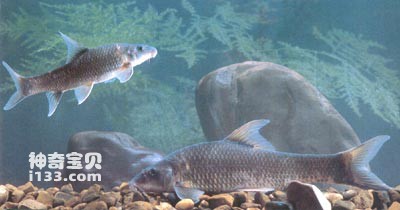Ptychidio jordani (Ptychidio jordani) belongs to the order Cypriniformes, family Cyprinidae, subfamily Ptychidio, and genus Ptychidio jordani. Commonly known as: Jiayu, rat fish, rat head fish. English name: Ratmouth barbel.
Body long, subcylindrical, slightly flattened at the rear. The head is small and the back is bulging, gradually becoming straighter back. The tip of the snout is protruding, the skin of the snout is thick, drooping, and has no snout folds. It covers the upper and lower jaws. The edge is deeply split into 10-12 tassels with many small papillae on the tassels. In the hypooral position, the upper lip disappears and the lower lip has a small, whisker-like protrusion. The upper jaw is pointed and has a fleshy frenulum connected to the lower lip at the base of the palps. The upper and lower jaws have sharp edges of horn; the retrolabial groove is limited to the corner of the mouth and is a deep groove extending backward to the eye. There are 2 pairs of barbels, both thick and long, slightly equal in size; the eyes are small, and the inter-eye space is narrow; the scales are small, and the lateral line scales are above 40. The dorsal fin has no hard spines; the body is brown, the back is brown-black, the abdomen is yellow-white, and there is a gray-black patch in the center of the scales; each fin is brown-black. During the breeding season, the male fish's snout, cheeks and head are covered with small white pearl-shaped particles, which feel obviously rough when touched by hand; the female fish has no star beads and the head is smoother. In the same batch of fish or fish of the same age, the female fish is always larger than the male fish and has a fuller abdomen.

The crocodile is a sedentary fish that likes to live in rivers with wide river beds, high flow rates, deep pools in the rivers, deep water sections with clear rocky bottoms, and caves with spring water; they mainly live in freshwater shellfish and clams. Food, also eat some freshwater sponges, algae and organic debris, aquatic insects, water earthworms, etc. The breeding season is from April to September every year, and a large number of eggs are laid in June and September. The spawning places are mostly distributed in the waters where they live and inhabit. The spawning places have fast currents and many deep pools. The eggs are mostly adhered to the gaps between stones, gravel and other objects, making them difficult to see.
The fish is distributed in the Pearl River system and Taiwan.
The juvenile stage of the crocodile fish grows faster, while the adult fish grows slower. Common individuals weigh 150-500 grams, and the largest individual can weigh up to 1 kilogram. Its meat is rich in fat, especially during the breeding season from May to September. The fat body continues to increase, which is much higher than during the non-reproductive season. The meat is tender, smooth and delicious, and the meat tastes excellent. It is well-known in ancient and modern times and is known as one of the four precious river delicacies in the Pearl River (perch, carp, mandarin fish and catfish). As early as the "Lingbiao Luyi" (AD 904) written by Liu Xun in the Tang Dynasty and "Guangdong Xinyu" (AD 1700) written by Qu Dayiao in the Qing Dynasty, there was information about the economic value and value of the crocodile. Records of the habitat. Zhou Qufei, a poet of the Song Dynasty, also said in his "Lingwai Daida" (1178 AD): "The body and abdomen of Jiayu have a lot of paste" and "It is also fried. Just put the fish in a dry cauldron, and a little paste will fall off naturally. There is no need to use oil when frying, it is called self-wrapping." This shows that the fish is rich in fat. The fish is mostly marketed in winter because the water in which it lives is deep and fast-flowing. Only in the dry season in winter when the water level is shallow and the riverbed stones are exposed can it be easily caught with a net.
animal tags:
We created this article in conjunction with AI technology, then made sure it was fact-checked and edited by a Animals Top editor.